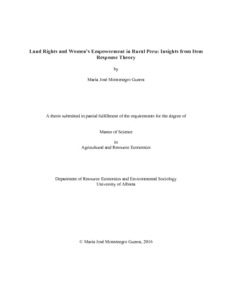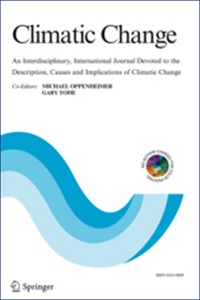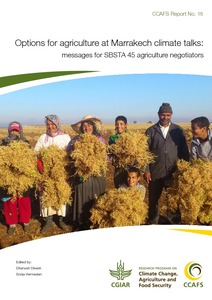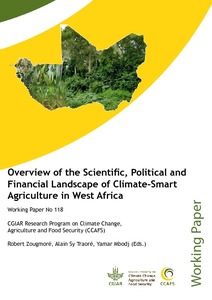Cambio climático
AGROVOC URI:
Land Rights and Women's Empowerment in Rural Peru: Insights from Item Response Theory
Women’s land rights are increasingly advocated as an empowerment tool to spur development outcomes. However, empirical evidence of this relationship is limited. In this study we use data from peasant communities in rural Peru to explore the effect of the intra-household allocation of inherited land on women’s empowerment. Empowerment is modeled as a latent variable measured by different influence indicators using a Generalized Structural Equation approach.
Malaria and large dams in sub-Saharan Africa: future impacts in a changing climate
Background: Sub-Saharan Africa (SSA) has embarked on a new era of dam building to improve food security and promote economic development. Nonetheless, the future impacts of dams on malaria transmission are poorly understood and seldom investigated in the context of climate and demographic change.
Managing Semi-Arid Rangelands for Carbon Storage: Grazing and Woody Encroachment Effects on Soil Carbon and Nitrogen
High grazing intensity and wide-spread woody encroachment may strongly alter soil carbon (C) and nitrogen (N) pools. However, the direction and quantity of these changes have rarely been quantified in East African savanna ecosystem. As shifts in soil C and N pools might further potentially influence climate change mitigation, we quantified and compared soil organic carbon (SOC) and total soil nitrogen (TSN) content in enclosures and communal grazing lands across varying woody cover i.e. woody encroachment levels.
Mapping adaptive capacity and smallholder agriculture: applying expert knowledge at the landscape scale
The impacts of climate change exacerbate the myriad challenges faced by smallholder farmers in the Tropics. In many of these same regions, there is a lack of current, consistent, and spatially-explicit data, which severely limits the ability to locate smallholder communities, map their adaptive capacity, and target adaptation measures to these communities.
Mapping gender preferences for tree and shrub forages
The book is structured to cover a range of gender issues in various forest, trees and agroforest management areas from tree species identification to landuse decision-making. Participatory research tools are featured such as ranking, mapping, modeling, participatory GIS; and other tools that can aid in looking at gender issues, roles and preferences primarily but not limited to agroforestry research and development.
Methods to investigate the hydrology of the Himalayan springs: a review
Springs are the major source of freshwater in many small mountainous watersheds within the Himalayan region. In recent years, their flow rates have diminished, but the reasons for this are not self-evident, and hence this paper reviews the methods to investigate Himalayan springs. The review reveals that chemical and isotope analyses – mostly water dating and stable isotope (e.g., d18O) analyses – could be an appropriate entry point to commence field investigations, because of their potential to map complex spring pathways, including linkages between aquifers.
Mud, muddle and models in the knowledge value chain to action on tropical peatland issues
Tropical peatlands are known not only for their high, area-based, carbon emissions in response to land-use change but also as hot spots of debate about associated data uncertainties. Perspectives are still evolving on factors underlying the variability and uncertainty. Debate includes the ways of reducing emissions through rewetting, reforestation and agroforestry.
Options for agriculture at Marrakech climate talks: messages for SBSTA 45 agriculture negotiators
SBSTA 45 in Marrakech represents a unique opportunity for Parties to decide on the future of agriculture within the UNFCCC. The process of discussions on issues related to agriculture initiated at COP17 in Durban 2011 culminates at COP22 in Marrakech 2016. The explicit reference to food security in the preamble of the Paris Agreement and the Intended Nationally Determined Contributions which prioritize agriculture as a sector for adaptation and mitigation actions, provide a foundation for Parties to develop appropriate frameworks to support
Overview of the Scientific, Political and Financial Landscape of Climate-Smart Agriculture in West Africa
The agricultural sector plays a key role in the Economic Community of West African States (ECOWAS). As the backbone of the economy, it affects society at many levels since national economies and people’s jobs, incomes and food security depend upon it. Climate change and variability pose a major threat to farmers in the region, which is already experiencing rising temperatures, shifting precipitation patterns, and increasing extreme events.





